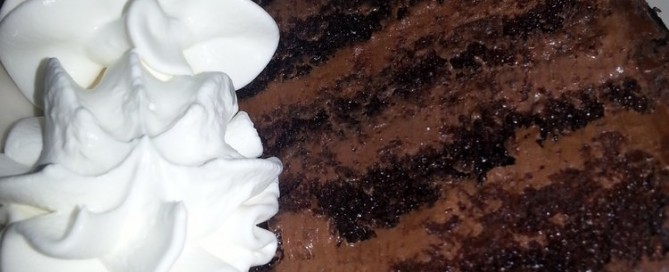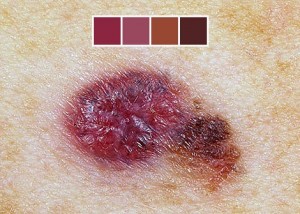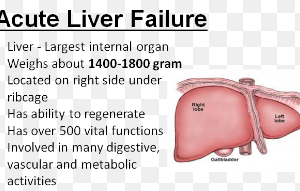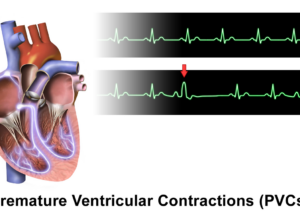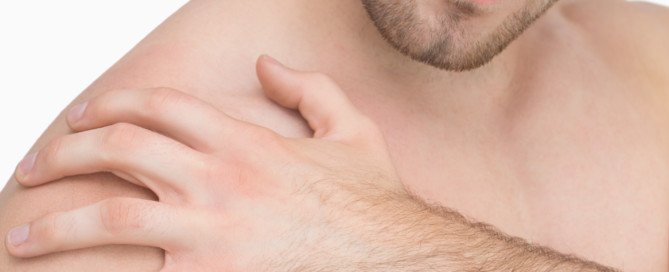Eat Linda’s Fudge Cake for Breakfast, Lose Weight

It’s possible to lose weight when you eat Linda’s Fudge Cake for breakfast.
First off, your body is in a state of fuel deficit when you get out of bed in the morning; it’s been fasting overnight. (more…)
Where on the Body Most Fatal Melanomas Are Located
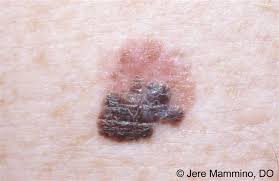
A study involving over 51,700 melanoma patients revealed that two particular locations on the body are more likely to have a fatal melanoma. (more…)
Can PVCs Lead to Congestive Heart Failure?
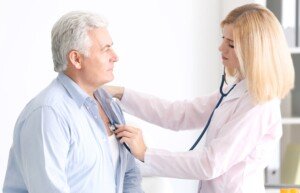
Normally, a premature ventricular contraction is nothing to worry about, but if you get too many, this can be linked to chronic heart failure. (more…)
Younger Men Seeking Older Women Place Less Value on Looks

Men who judge women by their looks (“her waist is too thick”) are labeled shallow.
But if a man prefers older women, he doesn’t care so much about looks.
(more…)
Can You Reverse the Flat Butt Curse by Gaining Fat?

There’s been no formal research on whether or not increasing the fat content of your body will transform a flat butt into a nice curvy round butt. (more…)
Does the Treadmill Calorie Display Change if You Hold On?

Is the calorie readout on a treadmill influenced by whether or not you hold onto the machine?
Inline Skating Guidelines for Plus Size Beginners

If you’re plus size, don’t begin inline skating ‘til you read these complete guidelines.
Inline skating can be so very fun for overweight or plus size women and men!
I’ve been inline skating for years, and even though I’m not overweight, I can offer the plus size wannabe inline skater some excellent guidelines for getting safely started with this fun form of exercise.
Best Defense Against Falling While Inline Skating
What makes someone fall backwards while inline skating is standing too straight.
A weight shift that causes the body to break past vertical, in a backwards direction, will result in a fall.
The more upright or erect the person is, the more likely a fall will occur. So the best prevention for averting a fall is to strength train the muscles that enable you to maintain a squat position with a forward lean of your trunk.
Think speed skaters at the Olympics. Ever notice how their trunks are virtually parallel to the ice?
Of course, this reduces drag, but it also prevents a backward fall. And yes, Olympic speed skaters fall, but not the same way that a recreational inline skater at the park or on a street falls.
Speed skaters in competition fall (which is almost always forward) due to miss-steps while making a turn, making contact with another skater or skating over something on the ice.
The recreational inline skater falls backwards because, quite simply, they were in a very inefficient position: erect, completely upright.
Now, skating over something on the ground, or over a pit in the ground, can make you pitch forward and fall on your face.
This problem is solved by watching carefully where you’re skating. A small ridge or deviation in the road could cause a forward tumble.
But to really reduce the likelihood of a fall, you must maintain a quarter squat, even third squat, position, with a forward lean of your trunk.
This positioning will very quickly fatigue your lower back and quadriceps muscles—unless you have these muscles trained with resistance.
Exercises for Plus Size Inline Skaters to Prevent Falls
• Squats
• Leg presses
• Leg extensions
• Seated rows
• Kettlebell Swings
• Bent-over Barbell Rows
You’re probably thinking, “What? That’s a LOT of exercises just to enjoy some inline skating!”
However, ask yourself what you hope to accomplish with inline skating other than having fun. I’m betting you’re also anticipating that this will be a good form of exercise.
So think of the six strength training exercises (pictured below) as an adjunct to your overall fitness program, and think of them as key exercises for the backward fall prevention.


Rafaelqcn, CreativeCommons

Shutterstock/lunamarina

Shutterstock/Microgen

Freepik.com

embhoo. CreativeCommons
A fall backwards can severely injure you.
The six exercises can easily be done by plus sized or overweight people. If you’re already doing most of these with correct form and with an intensity range that’s very challenging, you already have some stamina built up in your body to maintain the proper position for inline skating.
But the more intense or burning you make these exercises, the longer you’ll be able to maintain the squat and forward lean when skating.
In fact, with enough fitness built up in your core and legs, you’ll be able to effortlessly sustain this anti-backward-fall position: no aching or very little aching, no burning in the quads or lower back.
It’s simple: If your quads and lower back are used to the burning of a challenging strength training program, then simply holding the partial squat and trunk flexion position when skating will be a breeze — even if you’re plus size.
In addition to all that, sign up for a beginner’s course. That’s what I did, and I learned how to stop while coasting down a hill.
Do not feel self-conscious of your plus size or overweight body while inline skating. I’d love to see a heavy-set person engaging in this activity, but it hasn’t yet happened.
This doesn’t mean it’s not possible. One of my personal-training clients was quite heavy-set and told me she loved to inline skate — up and down hills.
 Lorra Garrick is a former personal trainer certified through the American Council on Exercise. At Bally Total Fitness she trained women and men of all ages for fat loss, muscle building, fitness and improved health.
Lorra Garrick is a former personal trainer certified through the American Council on Exercise. At Bally Total Fitness she trained women and men of all ages for fat loss, muscle building, fitness and improved health.
.
Top image: Freepik.com, photoangel
Should Obese People Do Barbell Squats?

Obesity is no excuse for avoiding the barbell squat, yet very few people at the “squatting cage” qualify as obese. (more…)
Can Interval Training Not Be Intense ?

There’s a difference between “interval training” and “high intensity interval training,” which is important to know if you can’t do strenuous exercise. (more…)
How to Improve Pushups if You Have Rotator Cuff Pain

Can you do pushups with a rotator cuff injury?
Pushups are a real bear when you have a rotator cuff injury.
I have had rotator cuff problems in the past. And my clients — when I was a personal trainer — have had rotator cuff pain as well.
I strongly advise against doing standard pushups if you have a problem with your rotator cuff.
This article pertains to non-tear rotator cuff pain.
Doing standard pushups in the midst of a rotator cuff injury or pain will not make the problem go away.
It’s not something you can “work out.” Tendons need a lot of tender loving care to heal, and rotator cuff injuries or strains involve small tendons that don’t get much blood circulation; hence, why it takes so long for them to heal.
The pushup motion recruits activity from some of the rotator cuff tendons.

Freepik.com, drobotdean
Anybody with a problematic rotator cuff will tell you that pushups bring on the pain, aching or discomfort.
And if pushups aggravate your rotator cuff problem, I needn’t tell you that bench pressing won’t be any better.
In fact, any chest routine will aggravate this type of injury, with maybe the exception of pec deck motions.
Here is how I kept pushups in my routine, despite having rotator cuff pain (which has long since dissolved). I used the flat side of a BOSU board.

Shutterstock/sanneberg
I placed my hands on the rim of the board, so that my fingers were curled around to the other side, on the soft side, and with the lower part of my palm still on the flat or black portion.
This way, my palms were facing each other. My chest was already warmed up from light dumbbell presses.
Never just dive into pushups when you have unresolved shoulder issues. Be plenty warmed up first.
Initially I did the pushups off my knees; military style brought on some pain, and anything that aggravates these tendons will interfere with healing and possibly make the situation worse.
I could feel the tendon problem lightly knocking on my door while doing knee pushups off the BOSU board.
And this is okay; just a tapping on the door, as opposed to outright pain, is acceptable and won’t impede the healing process.
I did 2-3 sets of eight reps. Over time I increased reps to 12, keeping the pain just outside my door.
And then I began taking weight off my knees, so that eventually, I was doing military style pushups, but still using the BOSU board flat side.
When it no longer felt like work to do this, and when my shoulder felt completely at ease, I eliminated the BOSU board entirely.
This process may sound simple, but it occurred over several months.
“We call it graded exposure,” says Dr. Logan Thomas, a physical therapist in Parker City, IN.
“Anytime we perform an exercise, our muscles, tendons and ligaments are exposed to a certain level of stress.
“If our tissue capacity is greater than the stress placed on it, we feel no pain.
“If the stress level exceeds our tissue capacity, our body signals a pain experience which is a built-in defense mechanism. Pain gets us to stop.”
My pushups now include my feet being elevated, body in a straight line, without any hint whatsoever of rotator cuff strain.
I’m not recommending that you should try to reinstate conventional pushups before your rotator cuff injury is healed.
I say to wait until the issue is fully healed before reinstating this chest exercise.
Otherwise, you will need loads of patience to work pushups back into your regimen while your rotator cuff is healing.
 Dr. Thomas a physical therapist, and strength and conditioning coach who is passionate about patient education. He believes the most important and often overlooked step in the process to becoming pain-free is understanding the anatomy and biomechanics of your body.
Dr. Thomas a physical therapist, and strength and conditioning coach who is passionate about patient education. He believes the most important and often overlooked step in the process to becoming pain-free is understanding the anatomy and biomechanics of your body.
 Lorra Garrick is a former personal trainer certified through the American Council on Exercise. At Bally Total Fitness she trained women and men of all ages for fat loss, muscle building, fitness and improved health.
Lorra Garrick is a former personal trainer certified through the American Council on Exercise. At Bally Total Fitness she trained women and men of all ages for fat loss, muscle building, fitness and improved health.

